Chevrolet Corvair First generation
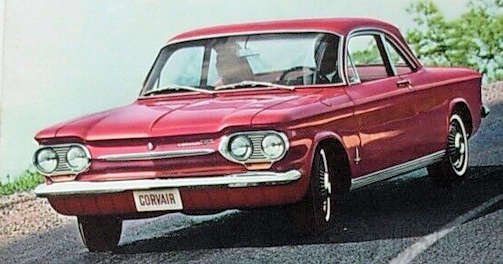 |
|
|
Production period: |
1959 to 1964 |
|
Manufacturer: |
Chevrolet |
|
Type: |
Motor car |
|
Engines: |
Gasoline: 2.3-2.7 litres |
|
Engine Location: |
Rear |
|
Drive: |
Rear wheels |
|
Cooling: |
Air cooled |
|
wheel base: |
108.00 in, 2743 mm |
|
overall length: |
180.04 in, 4752 mm |
|
overall height: |
51.50 in, 1308 mm |
|
ground clearance: |
6.00 in, 152 mm |
The first-generation Chevrolet Corvair is a rear engine rear-wheel drive passenger car from Chevrolet built from 1959 to 1964.
History
In October 1959, the Corvair was launched as a two-door coupe and four-door sedan, equipped as a 500 standard or 700 deluxe, powered by a six-cylinder boxer engine with nearly 2.3 litres and a carburettor per cylinder, the gross 80 SAE-hp (65 hp net / DIN, 48 kW) or with another camshaft 95 SAE-PS gross.
The passenger car with air-cooled six-cylinder boxer engine in the rear. This offered technical solution with rear engine made the Corvair unique the engine is in a separate rear Hood "bonnet" with good insulation at the bulkhead that no trace of vibration. At high speed the Corvair is exceptionally quiet from inside.
While for decades all American passenger cars followed the standard construction (water-cooled, longitudinally installed front engine, rear-wheel drive), GM oriented itself at the Corvair as the only American production car like the VW Beetle. As a concession to the US customers the larger six-cylinder with more than 2 litres of displacement was significantly more powerful than that of the VW beetle.
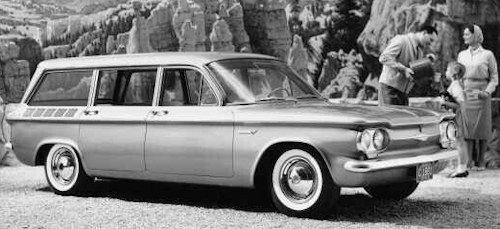
In addition to the four-door sedan, there was a five-door station wagon called Lakewood, a two-door coupe and a two-door convertible. Under the name Chevrolet Greenbrier Sportwagon was a minibus (similar to the VW bus). The body shape of the first series (1960 to 1964).
The gearbox was an automatic with two gears has a selector lever for the automatic transmission from the facia panel at a point which is convenient
the transmission which comprises an automatic two-speed gearbox and a torque converter of 2.60/1 maximum ratio the limitation of a two-speed transmission is more evident in that, as top gear automatically engages at 48 m.p.h. even during full-throttle acceleration (unless the selector is moved to "low"),there is no indirect ratio available for quick overtaking. There are also manual transmissions with three or four gears to choose from.
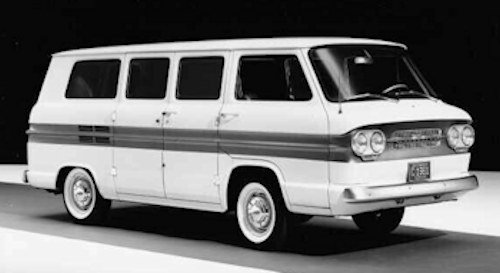
For the model year 1961, the program was extended to the equipment 900 Monza, a five-door station wagon called Lakewood, a minibus called Greenbrier, a van called Corvan, and the Corvair 95 as a pick-up. At the same time, the plant increased the displacement to 2.4 litres, while the nominal power remained unchanged. In the first years of production, the Corvair was quite successful and reached production figures of 200,000 to 300,000 pieces per year.
Inside legroom is good in front but limited at the rear the front seat is comfortable, wide enough for three people if necessary and with ample headroom.
The rear seat has adequate headroom, but cramped but Some more luggage space on a flat floor is provided between the rear wheels, and with the rear seat backrest folded forward to give a vast side-loading luggage space with a flat floor behind the front seat. Although the Corvair lacks a water-cooling system and the heating is provided petrol-burning installation mounted in the front luggage compartment and rather noisy in its working, and its three controls are a two-speed fan switch, a fully progressive temperature-control lever and a third lever which can divert extra-large amounts of heated air upwards for windscreen.
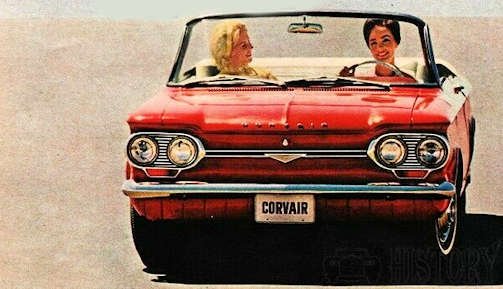
From 1962 there was the base model only as a coupe and in addition a convertible. These two two-door cars were also available as Monza Spyder with turbocharger and 150 hp / 152 hp. From autumn 1963, the engines were enlarged to 2.7 litres and made in suction 95 hp / 96 hp, with turbo in the Monza Spyder continues to 152 hp. The turbo version was increased again and last additionally offered with 2.9 litre engine and 180 hp. In addition, there was still for the year of construction 1964, the manufactured in the GM assembly plant in the Swiss Biel / Bienne four-door sedan with 2.7 litre engine and 112 hp (700 series, body type 1959-1964)
- PERFORMANCE: (145 cu in)
- max power (SAE): 80 hp at 4400 rpm
- max torque 17.7 kgm at 2300 rpm
- max number of engine rpm: 5000 (SAE): 128 1b ft
- specific power: 33.7 hp/l
- max speed in 1st gear: 30.4 mph, 49 km/h
- max speed in 2nd gear: 54 mph, 87 km/h
- max speed in 3rd gear: 90.1 mph, 145 km/h
- power- weight ratio: 30.4 lb/hp, 13.8 kg/hp
- FUEL CONSUMPTION: 20.2 m imp gal, 16.8 m US gal, 14 1 x 100 km;
- MAX SPEED: 90.1 mph, 145 km/h
The rear suspension of the Corvair existed until the model year 1964 from a pendulum axle, that is, the drive shafts guided by oscillating arms had joints on the inside of the differential and were rigidly connected to the outside of the hubs. The driving behaviour of the vehicles is typical for this construction: Up to the limit speed slightly oversteer and sporty to drive changes too high speed in curves (especially at bumps) the camber towards positive (the wheel bends inwards). The result is an abrupt increase in oversteer So a breakout of the car's rear. Some engineers at Chevrolet already had concerns about vehicle testing; The quite simple and reasonably priced suspension to be defused but only by specifying certain tire pressures - rear much higher than the front. Unfortunately, this information in the manual was misinterpreted as printing errors and not followed.
After numerous casualties and fatalities, the rear axle was redesigned in 1964 for the model year: an additional balancing spring was installed to reduce the rebound of the inside wheel. The harder suspension was no longer available; All vehicles now got a stronger stabilizer front. Also, the drum brakes were revised. The Corvair had a severe rear-engine vehicle of the time a weight distribution 60-63% on the rear axle and a tire pressure distribution, which was outside of the usual standard: 15/26 psi (1.0 / 1.8 bar) at the front / rear, The heavy motor and the swing axle introduced in conjunction with weak shock absorbers and cross-ply tires to "lack of straight running performance, crosswind sensitivity and transitional Wi oversteer ". Its handling characteristics corresponded in principle to the contemporary European rear-engine cars, however, these vehicles were much lighter and weaker motorized. While the usual American car was designed for understeer, the Corvair had to be steered in curves differently than the American driver was used to.
As a result, the demand for the Corvair dropped abruptly from 1966. The reputation of the relatively small, well motorized and therefore sporty-to-drive vehicle was ruined just as the improvements were introduced to the series. Due to the declining sales of the Corvair was discontinued in 1969 without successors.
With the Chevrolet Electrovair from 1964 and 1965, the General Motors Advanced Engineering Group developed two experimental vehicles with electric drive. The Corvair was chosen after the Corvette as the second-lightest car from Chevrolet for the conversion, the rear engine was beneficial. Both were based on the four-door sedan. In the first, the rear doors were welded shut to give the vehicle more rigidity. The traction battery of silver-zinc batteries with a total voltage of 532 V, the curb weight increased from 2500 lb (1134 kg) to about 3000 lb (1684 kg) and could be recharged about 100 times before it had to be replaced. The range per charge was 40 to 80 miles (about 65-130 km). The batteries filled out the entire suitcase and engine compartment. This made it necessary that components had to be accommodated instead of the rear seat bench. A 115-kW electric motor from AC Delco was used. With a peak of 80 mph (almost 130 km / h) and an acceleration of 16 seconds to 60 mph (96 km / h), the performance was comparable to the production car. The original equipment cost at that time with US $ 160,000 the multiple of a new car. Electrovair II is often referred to as the 1966 model.
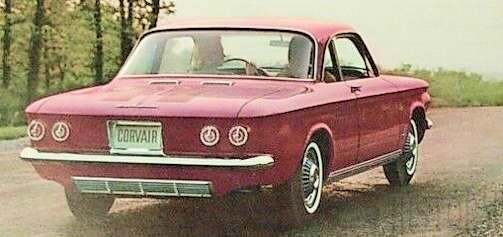
Technical
-
Chevrolet Corvair 1st gen Technical details and specifications (1959-1964)
ENGINES:
ENGINE: 2,295 c.c.
Cylinders: 6
Bore: 85.7 mm.
Stroke: 66 mm.
Cubic capacity: 2,295 c.c.
Piston area: 53.6 sq. in.
Valves: Pushrod o.h.v. (hydraulic tappets)
Compression ratio 8.0:1
Carburetter Two Rochester 1 1/4 in. downdraught, with automatic choke
Fuel pump: Mechanical
Ignition timing control:Centrifugal and Vacuum
Oil filter: Full-flow type also oil cooler in system
Max. power (gross):80 b.h.p.ENGINE: 2,370cc (145 cu in)
rear, 4 stroke
cylinders: 6, horizontally opposed
bore and stroke: 3.43 x 2.60 in, 87.1 x 66.0 mm
engine capacity: 145 cu in, 2370.75 cu cm
compression ratio: 8 : 1
cylinder block: light alloy
cylinder head: light alloy;
valves: 2 per cylinder, overhead, with push rods and rockers, hydraulic
system capacity: 3.8 imp qt, 4.5 US qt, 4.3 1
carburation: 2 Rochester downdraft single barrel carburettors
fuel feed: mechanical pump
cooling system: air-cooled.TRANSMISSION:
Saginaw driving wheels: rear
clutch: single dry plate
gear box. Mechanical gears: 3 + reverse
synchromesh gears: 2, 3
gear box ratios, (1) 3.50, (2) 1.99, (3) 1, (Rev) 3.97
gear lever location: central
Transmission Auto :Powerglide automaticThree-element hydraulic torque converter 2.60/1 maximum torque
Final drive: 9/32 hypoid bevel in unit with engine and gearbox.
final drive: hypoid bevel; ratio: 3.27 : 1.CHASSIS:
type Integral
front suspension: independent, wishbones, members on lower arms, coil springs, telescopic dampers
rear suspension: independent, swinging half-axles, coil springs, trailing arms, telescopic dampers.
Shock absorbers: telescopic Delco 1 in. boreSTEERING:
Saginaw recirculating ball
Turning circle between kerbs 37 feet
turns of steering wheel lock to lock: 4.6.BRAKES:
drum; braking surface: total 126.17 sq in, 813.80 sq cm.
drum internal dimensions 9 x 1 3/4 in. 198 sq. in. rubbed area of drums.
Hydraulic, duo-servo typeELECTRICAL EQUIPMENT:
voltage 12 V; battery: 42 Ah; ignition distributor: Delco-Remy; headlights: v4 front and reversing.
Interior lights: One sin roof, with courtesy switches on front doors and manual operation from main lighting switch.
Exterior lights: 2 sidelamps/turn indicators, 4 headlamps, 2 reversing lamps, number plate lamp, 2 stop/tail/turn indicator lamps.
Direction indicators: Self-cancelling flashers (white front and red rear)
Windscreen wipers: Delco electrical two-blade. self-parking.
Windscreen washers: Extra (washer button also starts wipers)INTERIOR INSTRUMENTS:
Locks : With ignition key: Ignition/starter switch, either front door, glove box and front luggage locker.
Glove lockers: One on facia with lockable lid
Ashtrays Cigar lighters One on facia
Speedometer with decimal total distance recorder
fuel contents gauge.
Warning lights: Turn indicators
headlamp main beam
dynamo charge (also indicates cooling fan belt failure)
oil pressure.
Interior heater: Automatic petrol-burning fresh-air heater and screen de-mister located in front luggage locker,
as optional extra. Car radio
Optional extra radio, folding rear seat, wheel trims, white wall tyres, two-tone paintwork,
Upholstery material: Woven plastic fabric
Sun visors Two, universally pivotedDIMENSIONS AND WEIGHT:
wheel base: 108.00 in, 2743 mm
front track: 54.50 in, 1384 mm
rear track: 54.50 in, 1384 mm
overall length: 180.04 in, 4752 mm
overall width: 66.98 in, 1700 mm
overall height: 51.50 in, 1308 mm
ground clearance: 6.00 in, 152 mm
dry weight: 2436 1b, 1105 kg
distribution of weight: 34 0/0 front axle, 66 0/0 rear axle
turning radius (between walls): 19.7 ft. 6 m'Production figures
- 1960: 250007
- 1961: 297881
- 1962: 306023
- 1963: 254571
- 1964: 199387
© Motor car History
Service
-
Chevrolet Corvair 1st gen Maintenance and Service Guide (1959-1964)
Automatic gearbox: 5 pints, automatic transmission fluid type A.
Rear axle: 2.6 pints, S.A.E. 80 hypoid gear oil
Steering gear lubricant: Gear oil
Chassis lubrication: By grease gun every 1,000 miles to 9 points.
Front wheel toe-in:3/32 in.
Camber angle: 0° to 1°
Castor angle: 5° to 5 1/2°
Steering swivel pin inclination: 7°
Tyre pressures: Front 15 lb. Rear 26 lb.
Brake fluid: type Delco
Battery type and capacity: 12-volt 35 amp. hr.
Battery mounting: Alongside rear-mounted engine, on right.
Number of electrical fuses 4, plus one circuit breaker in main lighting circuit.
Every 1,000 miles oil distributor and 2 dynamo bearings.
Every 5,000 miles clean dust off oil cooler element.
Jack: Lazy-tongs pattern with ratchet handle
Jacking points 4 external, under body sides
Standard tool kit: Jack, ratchet handle and wheel nut spanner.
tyres: 6.50—13 low-profile, 4-ply
rims: 5.50J
fuel tank capacity: 11.66 imp gal, 14.00 US gal, 53 1.2,295 c.c.
Oil change. 6.6 pints, S.A.E. 30 or (S.A.E. 10W)
Ignition timing: 4° before t.d.c. at tick-over (advance ranges, 32° centrifugal and 24±0 vacuum).
Contact-breaker gap: 0.019 in.
Sparking plug type: AC type 44-FF
Sparking plug gap: 0.023 to 0.028 in.
Valve timing: Inlet opens 15° before t.d.c. and closes 37° after b.d.c.; Exhaust opens 59° before b.d.c. and closes 13° after t.d.c.
Tappet clearances: Self adjusting
2,370cc (145 cu in)
fuel: petrol, 95-100 Oct
engine sump oil: 3.3 imp qt, 4.0 US qt, 3.8 1, SAE IOW (winter) 30 (summer), change every 6000 miles, 9600 km
gearbox oil: 0.8 imp qt, 0.9 US qt, 0.9 1; 2.0 US qt, 1.9 1
valve timing:
(inlet) opens 43 ° before tdc and closes 93 ° after bdc
(exhaust) opens 87 ° before bdc and closes 69 ° after tdc© Motor car History
-Note: Chevrolet Corvair 1st gen Advanced Maintenance and Repair Manuals available for registered users-
